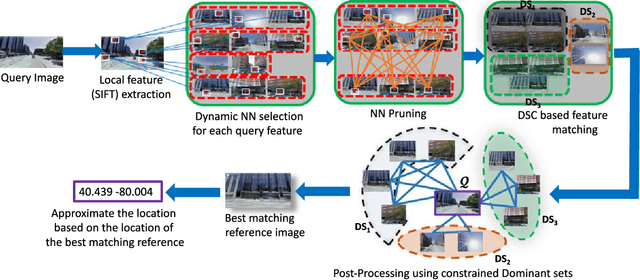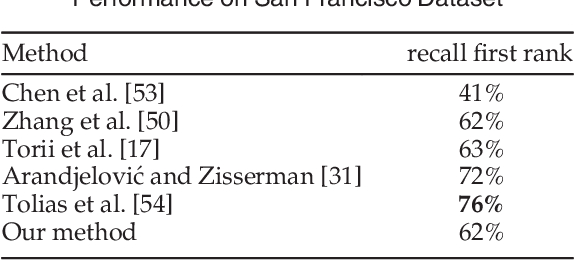Eyasu Zemene
Large-scale Image Geo-Localization Using Dominant Sets
Sep 14, 2017



Abstract:This paper presents a new approach for the challenging problem of geo-locating an image using image matching in a structured database of city-wide reference images with known GPS coordinates. We cast the geo-localization as a clustering problem on local image features. Akin to existing approaches on the problem, our framework builds on low-level features which allow partial matching between images. For each local feature in the query image, we find its approximate nearest neighbors in the reference set. Next, we cluster the features from reference images using Dominant Set clustering, which affords several advantages over existing approaches. First, it permits variable number of nodes in the cluster which we use to dynamically select the number of nearest neighbors (typically coming from multiple reference images) for each query feature based on its discrimination value. Second, as we also quantify in our experiments, this approach is several orders of magnitude faster than existing approaches. Thus, we obtain multiple clusters (different local maximizers) and obtain a robust final solution to the problem using multiple weak solutions through constrained Dominant Set clustering on global image features, where we enforce the constraint that the query image must be included in the cluster. This second level of clustering also bypasses heuristic approaches to voting and selecting the reference image that matches to the query. We evaluated the proposed framework on an existing dataset of 102k street view images as well as a new dataset of 300k images, and show that it outperforms the state-of-the-art by 20% and 7%, respectively, on the two datasets.
Dominant Sets for "Constrained" Image Segmentation
Jul 15, 2017



Abstract:Image segmentation has come a long way since the early days of computer vision, and still remains a challenging task. Modern variations of the classical (purely bottom-up) approach, involve, e.g., some form of user assistance (interactive segmentation) or ask for the simultaneous segmentation of two or more images (co-segmentation). At an abstract level, all these variants can be thought of as "constrained" versions of the original formulation, whereby the segmentation process is guided by some external source of information. In this paper, we propose a new approach to tackle this kind of problems in a unified way. Our work is based on some properties of a family of quadratic optimization problems related to dominant sets, a well-known graph-theoretic notion of a cluster which generalizes the concept of a maximal clique to edge-weighted graphs. In particular, we show that by properly controlling a regularization parameter which determines the structure and the scale of the underlying problem, we are in a position to extract groups of dominant-set clusters that are constrained to contain predefined elements. In particular, we shall focus on interactive segmentation and co-segmentation (in both the unsupervised and the interactive versions). The proposed algorithm can deal naturally with several type of constraints and input modality, including scribbles, sloppy contours, and bounding boxes, and is able to robustly handle noisy annotations on the part of the user. Experiments on standard benchmark datasets show the effectiveness of our approach as compared to state-of-the-art algorithms on a variety of natural images under several input conditions and constraints.
Multi-Target Tracking in Multiple Non-Overlapping Cameras using Constrained Dominant Sets
Jun 19, 2017



Abstract:In this paper, a unified three-layer hierarchical approach for solving tracking problems in multiple non-overlapping cameras is proposed. Given a video and a set of detections (obtained by any person detector), we first solve within-camera tracking employing the first two layers of our framework and, then, in the third layer, we solve across-camera tracking by merging tracks of the same person in all cameras in a simultaneous fashion. To best serve our purpose, a constrained dominant sets clustering (CDSC) technique, a parametrized version of standard quadratic optimization, is employed to solve both tracking tasks. The tracking problem is caste as finding constrained dominant sets from a graph. In addition to having a unified framework that simultaneously solves within- and across-camera tracking, the third layer helps link broken tracks of the same person occurring during within-camera tracking. In this work, we propose a fast algorithm, based on dynamics from evolutionary game theory, which is efficient and salable to large-scale real-world applications.
Interactive Image Segmentation Using Constrained Dominant Sets
Aug 03, 2016



Abstract:We propose a new approach to interactive image segmentation based on some properties of a family of quadratic optimization problems related to dominant sets, a well-known graph-theoretic notion of a cluster which generalizes the concept of a maximal clique to edge-weighted graphs. In particular, we show that by properly controlling a regularization parameter which determines the structure and the scale of the underlying problem, we are in a position to extract groups of dominant-set clusters which are constrained to contain user-selected elements. The resulting algorithm can deal naturally with any type of input modality, including scribbles, sloppy contours, and bounding boxes, and is able to robustly handle noisy annotations on the part of the user. Experiments on standard benchmark datasets show the effectiveness of our approach as compared to state-of-the-art algorithms on a variety of natural images under several input conditions.
 Add to Chrome
Add to Chrome Add to Firefox
Add to Firefox Add to Edge
Add to Edge